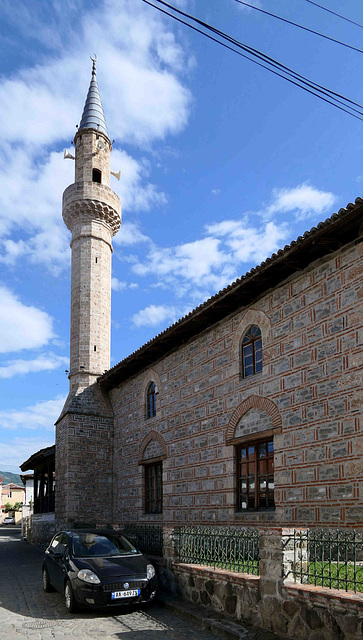Location
Lat, Lng: 41.114097, 20.081181
You can copy the above to your favourite mapping app.
Address: King Mosque
You can copy the above to your favourite mapping app.
Address: King Mosque
See also...
Keywords
Authorizations, license
-
Visible by: Everyone -
All rights reserved
-
36 visits
Ebasan - King Mosque


After the end of the Macedonian-Roman War in 168 BC, Illyria came under Roman protectorate and in 146 BC the Romans built the Via Egnatia trade route, which was a direct link between Rome and Byzantium as a continuation of the Via Appia. Rest areas were established at regular intervals along this route, one of which was in Scampa, what is Elbasan today.
Scampa was developed into a fortress by the Romans. Even today, the remains of late antique walls are still visible in some places up to a height of three metres. The position of the wall rectangle of 348 metres by 308 metres still forms the boundary of the old town today. The Via Egnatia ran through the two city gates located in the centre of the west and east sides.
Scampa became the seat of a bishop in the 5th century. The remains of an early basilica were uncovered on a hill outside the city walls. From the 7th century onwards, there were Slavic invasions and the town was destroyed by fire. The place was then probably abandoned. It is unclear whether a settlement existed under the Byzantines.
It may still have been abandoned when the Ottomans built a military camp there and a massive four-sided castle was constructed in order to fight Skanderbeg, due to an ongoing conflict between the Ottomans and Albanians. In 1467 many Christians from Skopje, Ohrid, Serres and Kastoria were forcibly deported to Elbasan. By the end of the 17th century it had 2,000 inhabitants. At the beginning of the 20th century it was estimated that 15,000 people lived in Elbasan.
The King Mosque is considered the oldest preserved mosque in Albania. Built at the end of the 15th century, the mosque is located in the old town within the fortress walls. The mosque consists of a quadrangular prayer room, the sides of which are around 14 metres long. In front of it is a wooden vestibule and in the north-west corner stands the minaret.
After religion was banned in Albania in 1967, the building was repurposed and altered. It served as a centre for popular political education. By 1979, only the prayer room remained of the building - the minaret had been demolished. In 2013, the mosque was extensively and faithfully restored. The minaret was also rebuilt.
Scampa was developed into a fortress by the Romans. Even today, the remains of late antique walls are still visible in some places up to a height of three metres. The position of the wall rectangle of 348 metres by 308 metres still forms the boundary of the old town today. The Via Egnatia ran through the two city gates located in the centre of the west and east sides.
Scampa became the seat of a bishop in the 5th century. The remains of an early basilica were uncovered on a hill outside the city walls. From the 7th century onwards, there were Slavic invasions and the town was destroyed by fire. The place was then probably abandoned. It is unclear whether a settlement existed under the Byzantines.
It may still have been abandoned when the Ottomans built a military camp there and a massive four-sided castle was constructed in order to fight Skanderbeg, due to an ongoing conflict between the Ottomans and Albanians. In 1467 many Christians from Skopje, Ohrid, Serres and Kastoria were forcibly deported to Elbasan. By the end of the 17th century it had 2,000 inhabitants. At the beginning of the 20th century it was estimated that 15,000 people lived in Elbasan.
The King Mosque is considered the oldest preserved mosque in Albania. Built at the end of the 15th century, the mosque is located in the old town within the fortress walls. The mosque consists of a quadrangular prayer room, the sides of which are around 14 metres long. In front of it is a wooden vestibule and in the north-west corner stands the minaret.
After religion was banned in Albania in 1967, the building was repurposed and altered. It served as a centre for popular political education. By 1979, only the prayer room remained of the building - the minaret had been demolished. In 2013, the mosque was extensively and faithfully restored. The minaret was also rebuilt.
- Keyboard shortcuts:
Jump to top
RSS feed- Latest comments - Subscribe to the comment feeds of this photo
- ipernity © 2007-2025
- Help & Contact
|
Club news
|
About ipernity
|
History |
ipernity Club & Prices |
Guide of good conduct
Donate | Group guidelines | Privacy policy | Terms of use | Statutes | In memoria -
Facebook
Twitter











Sign-in to write a comment.